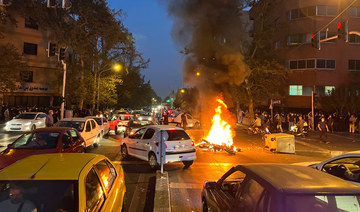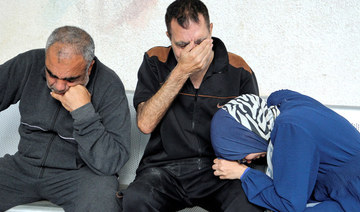PARIS/SULAIMANIYA, Iraq: Iran’s Revolutionary Guards said on Wednesday they fired missiles and drones at militant targets in the Kurdish region of neighboring northern Iraq, where authorities said 13 people were killed.
The strikes were reported after Iranian authorities accused armed Iranian Kurdish dissidents of involvement in unrest now shaking Iran, especially in the northwest where most of the country’s population of over 10 million Kurds live.
Thirteen people were killed and 58 wounded in the attacks near Irbil and Sulaimaniya in Iraqi Kurdistan, Iraq’s state news agency said citing its counter-terrorism service in Kurdistan.
Iraqi Kurdish sources told Reuters drone strikes targeted at least 10 bases of Iranian Kurds near Sulaimaniya in Iraqi Kurdistan on Wednesday morning, without elaborating about possible casualties.
The US Army Central Command said it downed an Iranian drone on Wednesday while it was on its way to Irbil, adding that the drone posed a threat to US personnel in the region.
“No US forces were wounded or killed as a result of the strikes and there is no damage to US equipment,” it said in a statement.
A senior member of Komala, an exiled Iranian Kurdish opposition party, told Reuters that several of their offices were struck as well.
Tariq Haidari, mayor of the Iraqi Kurdish city of Koye, told Reuters that two people including a pregnant woman were killed and 12 wounded. Some of the wounded were rushed in critical condition to hospital in Irbil, he said.
The Revolutionary Guards, Iran’s elite military and security force, said after the attacks that they would continue targeting what it called terrorists in the region.
“This operation will continue with our full determination until the threat is effectively repelled, terrorist group bases are dismantled, and the authorities of the Kurdish region assume their obligations and responsibilities,” the Guards said in a statement read on state television.
Iraq’s foreign ministry condemned the attacks.
Iraq’s foreign ministry spokesman said in a statement on Wednesday that the ministry would summon the Iranian ambassador to inform him of Iraq’s objection to the attacks on Iraqi territories and that Iraq considers this action as a violation of sovereignty.
The attacks were condemned by the UN mission in Iraq.
The US condemned the “brazen attacks” and Britain said Iraq’s “indiscriminate bombardment” demonstrates “a repeated pattern of Iranian destabilizing activity in the region”.
Germany slammed the “escalation... against the backdrop of domestic political protests in Iran” and rejected “attempts to locate the causes of the Iranian protests in the neighboring country”.
The Kurdish Democratic Party of Iran, one of the groups targeted, charged that “these cowardly attacks are occurring at a time when the terrorist regime of Iran is unable to crack down on ongoing protests inside and silence the Kurdish and Iranian peoples’ civil resistance”.
Protests erupted in Iran this month over the death of a young Iranian Kurdish woman, Mahsa Amini, in police custody.
Amini, 22, from the northwestern Kurdish city of Saqez, was arrested on Sept. 13 in the capital Tehran for “unsuitable attire” by the morality police, who enforce the Islamic Republic’s strict dress code.
She died three days later in hospital after falling into a coma, sparking the first big show of opposition on Iran’s streets since authorities crushed protests against a rise in gasoline prices in 2019.
On Wednesday, Iran’s President Ebrahim Raisi condemned the “chaos” sparked by a wave of women-led protests over Amini death.
“Those who took part in the riots must be dealt with decisively, this is the demand of the people,” said Raisi in a televised interview.
“People’s safety is the red line of the Islamic republic of Iran and no one is allowed to break the law and cause chaos,” he said.
“The enemy has targeted national unity and wants to pit people against each other,” added the ultraconservative president, accusing Iran’s archfoe the United States of stoking the unrest.
Raisi said the nation had felt “grief and sorrow” over Amini death, and that forensics and judiciary experts would soon present a final report, but also warned that “protests are different to riots”.
“Woman, Life, Freedom!” the protesters have chanted in Iran’s biggest demonstrations in almost three years, in which women have defiantly burned their headscarves and cut off their hair.
Their actions have been matched in solidarity protests worldwide, with British-Iranian Nazanin Zaghari-Ratcliffe, who spent six years in jail in Iran, cutting her hair in a video shared on the BBC Persian service.
Amini’s bereaved parents have filed a complaint, demanding “a thorough investigation” and the release of “all videos and photographs” of her while in custody, said their lawyer Saleh Nikbakht.
An Iraq-based cousin of Amini, who is a member of a Kurdish nationalist group, charged that she died after a “violent blow to the head” and that one officer had vowed to “instil the rules in her and teach her how to wear the hijab and how to dress”.
As the Iranian protests have flared for 12 nights in a row, Iran’s police command vowed its forces would confront them “with all their might”, in a crackdown that one rights group says has already killed at least 76 people.
The Iranian government — its economy already hit by sanctions over its nuclear program — has sought to play down the crisis.
Iranian Foreign Minister Hossein Amir-Abdollahian said he told Western diplomats at recent UN meetings that the protests were “not a big deal” for the stability of the clerical state.
“There is not going to be regime change in Iran. Don’t play to the emotions of the Iranian people,” he told National Public Radio in New York, also accusing “outside elements” of stirring up violence.
Fars news agency said Tuesday “around 60” people had been killed since Amini’s death. But the Oslo-based group Iran Human Rights said the crackdown has killed at least 76 people.
Iran’s response has drawn concern from the UN and condemnation from the around the world, with Germany and Spain summoning the Iranian ambassadors and the US and Canada announcing new sanctions.
The son of Iran’s late shah, in an interview near Washington with AFP, hailed the protests and urged the world to add to the pressure on the clerical leadership.
Reza Pahlavi, whose father was toppled in the 1979 Islamic Revolution, urged greater preparation for a future Iranian system that is secular and democratic.
“It is truly in modern times, in my opinion, the first revolution for the women, by the women — with the support of the Iranian men, sons, brothers and fathers,” said Pahlavi.
Thirteen reported killed as Iran Revolutionary Guards target dissident sites in Iraq
https://arab.news/4jc7b
Thirteen reported killed as Iran Revolutionary Guards target dissident sites in Iraq
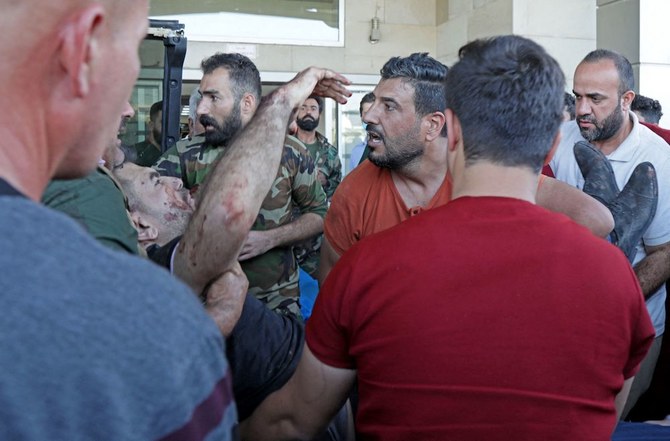
- Iranian authorities accuse Iranian Kurdish dissidents of involvement in unrest
- Drone strikes targeted at least 10 bases of Iranian Kurds near Sulaimaniya in Iraqi Kurdistan
UN experts condemn Israel’s ‘sexual assault and violence’ in Gaza

“We are appalled that women are being targeted by Israel with such vicious, indiscriminate and disproportionate attacks, seemingly sparing no means to destroy their lives and deny them their fundamental human rights,” the seven special rapporteurs said in a statement.
Special rapporteurs are independent experts appointed by the UN Human Rights Council. They do not speak on behalf of the United Nations.
The statement pointed to “continued reports of sexual assault and violence against women and girls, including against those detained by Israeli occupation forces.”
They cited UN reports saying women and girls in Gaza were victims of enforced disappearances.
Referring to Hamas, which runs the besieged Palestinian territory, Israel’s mission in Geneva alleged the experts had “once again chosen to ignore Hamas’s systematic militarization of health facilities and civilian infrastructures in the Gaza Strip, voluntarily and actively using the population as human shields.”
“In issuing such a statement, the signatories try to create an alternative narrative, parroting the agenda of a terrorist organization that is actively destroying the lives of the Palestinian population in Gaza,” the Israeli mission said.
The bloodiest-ever Gaza war started after an unprecedented attack on southern Israel by militants from Hamas on October 7.
The attack resulted in the deaths of 1,170 people, mostly civilians, according to an AFP tally of Israeli official figures.
Israel’s relentless retaliatory military offensive has killed more than 34,700 people in Gaza — most of them women and children — according to Gaza’s health ministry.
The UN experts said Israel’s widespread destruction of housing in Gaza and the fact that Palestinians were having to live in “precarious” conditions in makeshift tents had a disproportionate impact on women and girls, particularly on their personal security and privacy.
“The treatment of pregnant and lactating women continues to be appalling, with the direct bombardment of hospitals and deliberate denial of access to health care facilities by Israeli snipers,” they added.
More than 180 women per day were giving birth without pain relief, while hundreds of babies have died due to a lack of electricity for incubators, they said.
These conditions have led to a surge in miscarriages, the experts said.
They said Israeli forces had “destroyed Gaza’s largest fertility clinic,” which stored embryos, and estimated that 690,000 women and girls in Gaza were deprived of menstrual hygiene products.
The Israeli mission in Geneva said Israel “categorically rejects unsubstantiated allegations of sexual assaults and violence.”
It said Israel was ready to investigate “any concrete claims of misconduct by its security forces when presented with credible allegations and evidence.”
The UN experts said “the government of Israel has continuously failed to conduct an independent, impartial and effective investigation into the reported crimes.”
‘Where can we go?’ say Rafah residents as Israel demands evacuation

- Areas designated for evacuation currently shelter some 250,000 people
- Israel’s retaliatory offensive, aimed at destroying Hamas, has killed at least 34,683 people in Gaza, mostly women and children
Rafah: Palestinian civilians in the southern Gazan city of Rafah voiced despair on Monday as Israel dropped fliers urging them to evacuate for their own “safety” ahead of a “limited” military operation.
Israel’s army said it was instructing Palestinian families in eastern Rafah to flee in preparation for an expected ground assault on the city which abuts Gaza’s border with Egypt.
Residents of Rafah described emerging outside after a terrifying night in which around a dozen air strikes were carried out on Rafah, to find fliers falling from the sky telling them to “evacuate immediately.”
“The army is working with intensive power against the terrorist forces near you,” read a flier circulated in eastern Rafah.
“For your safety, the IDF (Israeli military) tells you to evacuate immediately toward the expanded humanitarian zone of Al-Mawasi,” it said, with a map indicating the location to the north of Rafah.
Osama Al-Kahlout, of the Palestinian Red Crescent Society in Gaza, told AFP that the areas designated for evacuation currently shelter some 250,000 people, many of whom have already been displaced from other areas in the Gaza Strip.
“The evacuation process has begun on the ground, but in a limited manner,” he said.
An Israeli militark spokesman, when asked how many people should move, said: “The estimate is around 100,000 people.”
About 1.2 million people are currently sheltering in Rafah, according to the World Health Organization, most having fled there during the seven-month war between Israel and Hamas Palestinian militants.
Amid pouring rain, some of those sheltering in Rafah said they had begun packing up their things from the densely packed tents and preparing to leave even before Israel’s directive arrived.
“Whatever happens, my tent is ready,” a resident told AFP.
But others said the area they were being told to flee to was already overcrowded, and they did not trust that it would be safe.
Abdul Rahman Abu Jazar, 36, said he and 12 family members were in the designated evacuation area.
Jazar and his family did not know what to do, he said, because the “humanitarian zone” they were told to head for “does not have enough room for us to make tents because they are (already) full of displaced people.”
“Where can we go? We do not know,” he told AFP.
“There are also no hospitals and it is far from any services many need,” he said, adding that one of his family members relied on dialysis at the Al-Najar hospital, in the area of Rafah instructed to evacuate.
“How will we deal with her after that? Should we watch her die without being able to do anything?“
An Israeli military spokesman told reporters that the evacuation “is part of our plans to dismantle Hamas ... we had a violent reminder of their presence and their operational abilities in Rafah yesterday.”
On Sunday, four Israeli soldiers were killed and others wounded, the army said, when a barrage of rockets was fired toward the Kerem Shalom border crossing between Israel and Gaza.
The army said the rockets were fired from an area adjacent to Rafah.
International aid organizations have voiced alarm at the expected invasion of Rafah.
“From the humanitarian perspective, no credible humanitarian plan for an attack on Rafah exists,” said Bushra Khalidi, advocacy director for Oxfam in the Palestinian territories.
She said she could “not fathom that Rafah will happen,” asking where displaced Palestinians will go “when most of their surroundings have been reduced to death and rubble?“
Gaza’s bloodiest-ever war broke out following Hamas’s unprecedented October 7 attack on Israel which resulted in the deaths of more than 1,170 people, mostly civilians, according to an AFP tally of Israeli official figures.
Militants also seized some 250 hostages, with Israel estimating that 128 of them remain in Gaza, including 35 whom the military says are dead.
Israel’s retaliatory offensive, aimed at destroying Hamas, has killed at least 34,683 people in Gaza, mostly women and children, according to the Hamas-run territory’s health ministry.
US weapon system identified in Israeli-Lebanon strike may breach international law

- Guardian investigation with Human Rights Watch identifies Boeing-made Joint Direction Attack Munition fragments at site where aid workers were killed
- US bans export of such systems to foreign militaries where ‘credible information’ of human rights breaches exists
LONDON: An Israeli airstrike in Lebanon that killed seven aid workers in March may have been conducted with a US-supplied weapon system, according to an investigation by The Guardian.
The incident claimed the lives of seven paramedics aged 18-25, all volunteers, at an ambulance center in Al-Habariyeh in southern Lebanon on March 27.
It came five days before an Israeli strike in Gaza killed seven aid workers working for World Central Kitchen.
Debris found at the scene in Al-Habariyeh was identified by The Guardian, an independent expert and Human Rights Watch as having belonged to a 500-pound Israeli MPR bomb and a Boeing-made Joint Direction Attack Munition, a system attached to explosives to turn them from “dumb bombs” into GPS-guided weapons.
HRW’s Lebanon researcher Ramzi Kaiss told The Guardian: “Israel’s assurances that it is using US weapons lawfully are not credible. As Israel’s conduct in Gaza and Lebanon continues to violate international law, the Biden administration should immediately suspend arms sales to Israel.”
The US government is legally unable to help or arm foreign militaries where “credible information” of human rights abuses exists, under the terms of the 1997 Leahy law.
A spokesperson for the US National Security Council told The Guardian: “The US is constantly working to ensure defense articles provided by the US are being used consistent with applicable domestic and international law. If findings show violations, we take action.”
But Josh Paul, a non-resident fellow with Democracy for the Arab World Now and a former State Department employee, said: “The State Department has approved several of these (weapons) transfers on a 48-hour turnaround. There is no policy concern on any munitions to Israel other than white phosphorus and cluster bombs.”
He added that JDAMs have been “key items” regularly requested by Israel since the start of the Gaza war.
Secretary of State Antony Blinken will deliver a report on Wednesday to Congress on Israel’s use of American weapons and whether they may have been involved in violations of this or other laws.
Maryland Sen. Chris Van Hollen told The Guardian that the findings from Al-Habariyeh are “deeply concerning and must be fully investigated by the Biden administration, and their findings should certainly be included in the NSM-20 report that is due to be submitted to the Congress on May 8.”
The airstrike on the ambulance center in Al-Habariyeh came without warning before 1 a.m. on March 27. No fighting had been reported in the area.
The victims had been at the center for the night shift, and were named as twin brothers Hussein and Ahmad Al-Shaar, aged 18; Abdulrahman Al-Shaar, 19; Mohammad Hamoud, 21; Mohammad Al-Farouk Aatwi, 23; Abdullah Aatwi, 24; and Baraa Abu Kaiss, 24.
The Israeli military claimed that the strike, which leveled the two-storey building, killed a “prominent terrorist belonging to Jamaa Islamiya,” an armed Lebanese political group with ties to Hezbollah. It did not identify the person by name.
A Jamaa Islamiya spokesman acknowledged that some of the ambulance volunteers were members of the group, but denied that they were part of its armed wing.
Samer Hardan, head of the local Civil Defense center who was among the first responders, told The Guardian: “We examined every centimetre looking for parts of bodies and their possessions. We saw nothing military-related. We knew (the victims) personally, so we could identify their remains.”
Since Oct. 7, 16 medical workers have been killed by Israeli airstrikes in Lebanon, and a further 380 people have died including 72 civilians. Eleven Israeli soldiers and eight civilians have also been killed.
Kassem Al-Shaar, father of Ahmad and Hussein, said he had warned his sons not to volunteer.
“I told them that it was dangerous to do this type of work, but they said that they accepted the risk. I don’t know what Israel was thinking — these were young people excited to help others,” he said.
“My sons wanted to do humanitarian work, and look what happened to them. Israel wouldn’t dare to do what they did if it wasn’t for the US standing behind them.”
Aid groups issue urgent appeal for Yemen funds
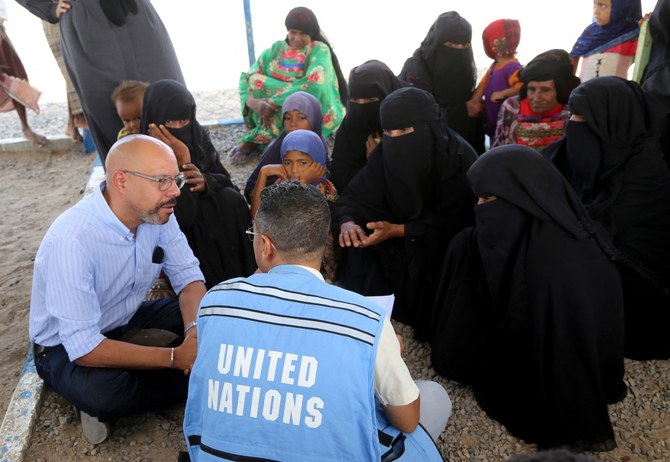
- UN agencies warned that 18.2 million people in need of help after nine years of war
Dubai: Nearly 200 aid groups appealed on Monday for funds to bridge a $2.3 billion shortfall in assistance for war-torn Yemen, warning of potentially “catastrophic consequences” for the Arabian Peninsula’s poorest country.
A joint statement from 188 humanitarian organizations, including several UN agencies, warned that 18.2 million people — more than half the population — were in need of help after nine years of war.
Their appeal came a day before a meeting of high-ranking EU officials in Brussels to discuss the aid program for Yemen, which is suffering one of the world’s worst humanitarian crises.
“Inaction would have catastrophic consequences for the lives of Yemeni women, children and men,” the statement said, calling Tuesday’s meeting a “critical moment.”
“The humanitarian community appeals to donors to urgently address existing funding gaps, and provide sustainable support to enhance resilience and reduce aid dependency.”
Yemen has been gripped by conflict since the Iran-backed Houthis overran the capital Sanaa in 2014, triggering the Saudi-led military intervention in support of the government the following year.
Hundreds of thousands have died in the fighting or from indirect causes such as a lack of food, the United Nations says.
Hostilities slowed considerably in April 2022, when a six-month, UN-brokered ceasefire came into effect, and they have remained at a low level since.
But only $435 million of the $2.7 billion called for in Yemen’s 2024 Humanitarian Response Plan requirement has been raised, the aid groups said, warning of threats including food insecurity, cholera and unexploded ordnance.
“Underfunding poses a challenge to the continuity of humanitarian programming, causing delays, reductions and suspensions of lifesaving assistance programs,” it said.
“These challenges directly affect the lives of millions who depend on humanitarian assistance and protection services for survival.”
UN atomic watchdog chief Rafael Grossi arrives in Iran: media
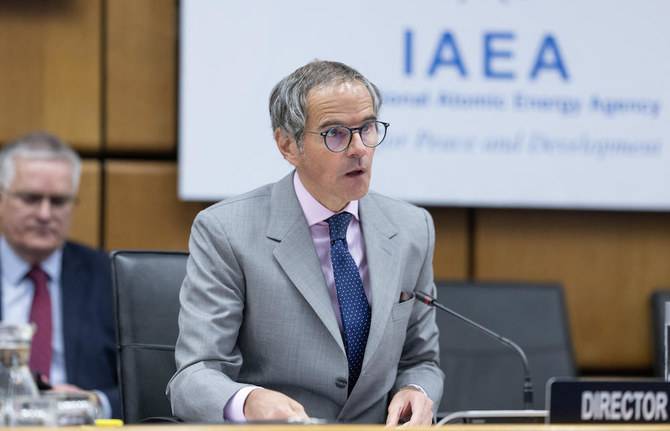
- Visit comes at a time of heightened regional tensions and with IAEA criticizing Iran for lack of cooperation on inspections and other outstanding issues
TEHRAN: UN atomic watchdog chief Rafael Grossi arrived Monday in Iran, where he is expected to speak at a conference and meet officials for talks on Tehran’s nuclear program.
“The Director General of the International Atomic Energy Agency arrived in Tehran on Monday at noon at the head of a delegation to participate in the nuclear conference and negotiate with top nuclear and political officials of the country,” Tasnim news agency said, with other agencies reporting the same details.
The visit comes at a time of heightened regional tensions and with the IAEA criticizing Iran for lack of cooperation on inspections and other outstanding issues.
Grossi, head of the IAEA, is expected to deliver a speech at Iran’s first International Conference on Nuclear Science and Technology.
The three-day event, which starts on Monday, is being held in Isfahan province, home to the Natanz uranium enrichment plant and where strikes attributed to Israel hit last month.
The IAEA and Iranian officials reported “no damage” to nuclear facilities after the reported attack on Isfahan, widely seen as Israel’s response to Iran’s first-ever direct attack on its arch foe days earlier, which itself was a retaliation for a deadly strike on Tehran’s Damascus consulate.
During his visit, Grossi is expected to meet with Iranian officials including the Islamic republic’s nuclear chief Mohammad Eslami.
On Wednesday Eslami, head of the Atomic Energy Organization of Iran, said he was “sure that these negotiations will further help clear ambiguities, and we will be able to strengthen our relations with the agency.”
Iran in recent years has deactivated IAEA monitoring devices at nuclear facilities and barred inspectors, according to the UN agency.
Grossi last visited Iran in March 2023 and met with top officials including President Ebrahim Raisi.
Iran has suspended its compliance with caps on nuclear activities set by a landmark 2015 deal with major powers after the United States in 2018 unilaterally withdrew from the agreement and reimposed sweeping sanctions.
Tensions between Iran and the IAEA have repeatedly flared since the deal fell apart, while EU-mediated efforts have so far failed both to bring Washington back on board and to get Tehran to again comply with the terms of the accord.
Last year, Iran slowed down the pace of its uranium enrichment, which was seen as a goodwill gesture while informal talks began with the United States.
But the Vienna-based UN nuclear agency said Iran accelerated the production of 60-percent enriched uranium in late 2023.
Enrichment levels of around 90 percent are required for military use.
Tehran has consistently denied any ambition to develop nuclear weapons, insisting that its atomic activities were entirely peaceful.
In February, the IAEA said in a confidential report seen by AFP that Iran’s estimated stockpile of enriched uranium had reached 27 times the limit set out in the 2015 accord.
On Sunday, the Iranian official news agency IRNA said Grossi’s visit provides “an opportunity for the two sides to share their concerns,” especially with regard to the IAEA’s inspectors.
Iran in September withdrew the accreditation of several inspectors, a move described at the time by the UN agency as “extreme and unjustified.”
Tehran, however, said its decision was a consequence of “political abuses” by the United States, France, Germany and Britain.
Eslami said the IAEA has “more than 130 inspectors” working in Iran, insisting Tehran remains committed to cooperating with the nuclear watchdog.



